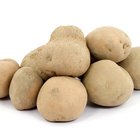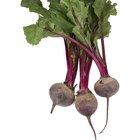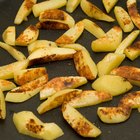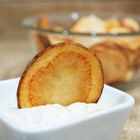
Sweet potatoes fit beautifully into a healthy but busy lifestyle. Not only do these mildly sweet tubers contain plenty of vitamin A and fiber, they also require little preparation. Make them well in advance of a meal and refrigerate or freeze them; unlike white potatoes, they won't lose their texture or flavor.
Cooking
Treat a sweet potato any way you'd cook a white or red potato. That includes baking, boiling, fire-roasting and frying. Sweet potatoes have a slightly higher sugar content than white potatoes, so fry or oven-roast sweet potato fries at a lower temperature or for less time than you would a white potato. Before baking them, was the potatoes and puncture the skin with a fork so they'll cook evenly. No matter which cooking method you use, make extra servings and store the remainder for later meals.
Storing
Like white potatoes, uncooked sweet potatoes don't require refrigeration. Store uncooked sweet potatoes in a cool, dry place for up to a month. Bake whole sweet potatoes ahead of time and refrigerate them for up to 10 days. Microwave them when you want a quick side dish or a satisfying small meal. You can also refrigerate or freeze sweet potato puree, then reheat it later as an ingredient or as a finished side dish. Prepare a sweet potato casserole and store it in the refrigerator to await baking at your convenience. As with any cooked food, refrigerate cooked sweet potatoes within two hours of preparing them.
Warming
Frozen cooked sweet potatoes require defrosting. The quickest method involves the microwave; just pop whole sweet potato pieces or a portion of puree into the microwave and defrost it according to your oven's directions. Check the potato frequently to ensure it isn't overheating. If you're working with puree, you can also defrost frozen sweet potatoes on the stove. As the potato puree heats, add just enough water, milk or stock to replace the water that freezing removes from food.
Serving
Sweet potatoes go anywhere white potatoes can go. You can mash them and serve them alongside a filet mignon or enjoy them with creamy dressing as steak fries. Try them stuffed with savory blends of herbs and other vegetables or a heartier meat filling. Sweet potatoes also venture into a part of the menu where other root vegetables fear to tread: dessert. The tuber's sugar content makes a baked sweet potato a self-contained dessert; top it with a sprinkle of cinnamon and nutmeg and a dollop of yogurt and your kids will enjoy it as a sweet treat that you know is also nutritious.
Related Articles
How to Boil Potatoes So They Can Be ...

How Do I Freeze Homemade Hash Browns?
How to Make Sweet Potato Baby Food

How to Steam Red Potatoes in an ...

How Do I Preserve Sliced Potatoes?

How do I Cook Potatoes for Hashbrown ...

How to Freeze Fresh Beets

How to Make and Keep Mashed Potatoes ...
Easy Sweet Potato Casserole Recipe

How Long Does Banana Bread Stay Fresh?
Does a Baked Potato Cook Faster if You ...

How to Sautee Potatoes

How to Bake White Potatoes

How to Cook Petite Red Potatoes

How to Roast Cornish Hens With Potatoes ...

What Are Yellow Potatoes?
Can I Freeze Cheesy Potatoes Before ...

How to Store Apples

Do Potatoes Cook Faster if You Poke ...

How To Make Potato Chips With a Deep ...
References
Writer Bio
Lauren Whitney covers science, health, fitness, fashion, food and weight loss. She has been writing professionally since 2009 and teaches hatha yoga in a home studio. Whitney holds bachelor's degrees in English and biology from the University of New Orleans.
Photo Credits
PhotoObjects.net/PhotoObjects.net/Getty Images